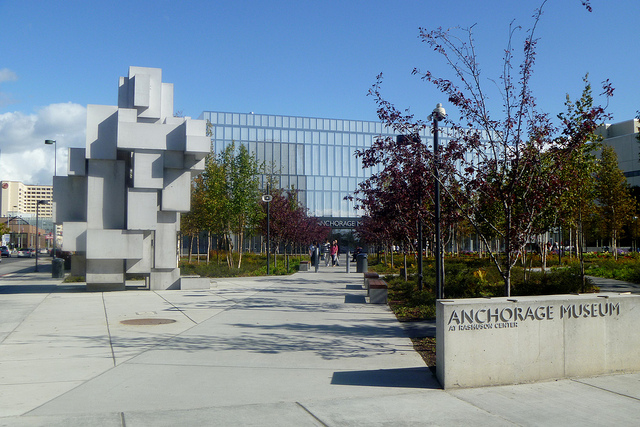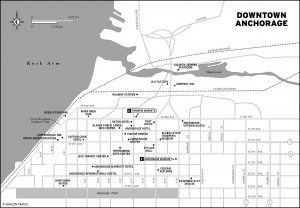
Photo © Ins1122, licensed Creative Commons Attribution.

Downtown Anchorage
It doesn’t take long to get the hang of downtown Anchorage. The blocks are square, with the lettered streets (A through L) going north–south and the numbered avenues (starting at 2nd Ave. just up the hill from the tracks) running east–west. Once you get east of the lettered streets they start over again using alphabetized names (Barrow, Cordova, Denali, Eagle, Fairbanks).Beyond downtown, the city of Anchorage sprawls across the Anchorage Bowl, with hillside homes peering down on the masses below. A number of neighborhoods are scattered around Anchorage, but most travelers are likely to spend their time in downtown and Midtown, a nondescript Anytown, USA, collection of malls, shopping centers, supermarkets, fast-food joints, bars, movie theaters, discount stores, gas stations, and other businesses just a 20-minute walk or a 10-minute bus ride south of downtown. Midtown is encompassed by Northern Lights and Benson Boulevards between Minnesota Drive and Old Seward Highway. It isn’t exactly a tourist attraction, but this, along with shopping malls on the south and east end of town, is where locals—and others looking to save money—spend their cash. Another large shopping district is along Dimond Boulevard in South Anchorage, where all the stalwarts are: Best Buy, Wal-Mart, Costco, Borders, CompUSA, and more.
Start your tour of downtown at the Anchorage Convention and Visitors Bureau (ACVB), a sod-roofed log cabin on the corner of 4th Avenue and F Street. The cabin isn’t actually the main place for information; go out the back door to a more spacious visitors center where you’ll find a plethora of brochures from around the state and helpful staff. Be sure to pick up a copy of the fat Anchorage Big Wild Life, which includes a walking tour of sights in downtown Anchorage and an Anchorage-area driving tour, plus details on sights, attractions, activities, lodging, restaurants, and more.
The ACVB office (907/274-3531) is open daily 7:30 a.m.–7 p.m. June–August, daily 8 a.m.–6 p.m. May and September, and daily 9 a.m.–4 p.m. October–April. The website is packed with information on the city and links to local businesses. Call 907/276-3200 for a recording of forthcoming events.
Free city buses (907/343-6543) run around downtown daily if you get tired of walking. They stop right in front of the ACVB. For a quick one-hour introduction to the city, hop on one of the red Anchorage City Trolley Tours (612 W. 4th Ave., 907/276-5603, $15) with daily departures on the hour 9 a.m.–6 p.m. May–mid-September.
Kitty-corner from the ACVB is the old Federal Building, which now houses the Alaska Public Lands Information Center (605 W. 4th Ave., 907/644-3661 or 866/869-6887, daily 9 a.m.–5 p.m. mid-May–early Sept., Mon.–Fri. 10 a.m.–5 p.m. early Sept.–mid-May). This is a great starting point to learn about federal lands in Alaska, including national parks and forests, wildlife refuges, and Bureau of Land Management areas. Displays introduce you to Alaska’s wildlife and wild places, daily historical walks are offered throughout the summer, the bookstore has a good selection of Alaskan titles, and the auditorium is used for nature videos and talks.
A few blocks away is the Department of Natural Resources Public Information Center (550 W. 7th Ave., 907/269-8400, Mon.–Fri.). Located on the 12th floor, the information center has helpful staff and details on state parks, public-use cabins, where to pan for gold, state land sales, and much more.
A massive $106 million expansion in 2009 transformed the Anchorage Museum (625 C St., 907/929-9200, $10 adults, $8 seniors, $7 ages 3–12, younger children free) into the state’s largest (170,000 square feet) and finest museum. One popular feature is the kid-friendly Imaginarium Discovery Center, with 80 hands-on science exhibits, including an amazing high-tech globe that displays today’s weather patterns, an air cannon, and pulley chairs. Many exhibits focus on Alaskan science, especially earthquakes and volcanoes. Also on the first level is a planetarium and a gallery of Alaskan art, including Sydney Laurence’s 6- by 10-foot oil of Mt. McKinley. The upper levels contain galleries featuring contemporary Native Alaskan art, Alaskan history, and rotating shows. Don’t miss the amazing second-floor collection of some 600 archaeological pieces on long-term loan from the Smithsonian Museum. In addition to exhibits, the Anchorage Museum has a fine gift shop and historical photos in the resource center. Watch Alaska films in the theater, or enjoy an upscale lunch at trendy Muse Restaurant (907/929- 210, closed Mon.). The museum is open daily 9 a.m.–5 p.m. (until 9 p.m. Thurs.) June–mid-September, and Sunday noon–6 p.m., Tuesday–Saturday 10 a.m.–6 p.m. mid-September–May. In the summer, free hourlong tours are offered, and local artists sell their crafts in the atrium. Outside is a two-acre commons, perfect for summer afternoons.
Anchorage’s central focal point is the Alaska Center for the Performing Arts (907/263-2900), better known as “the PAC,” short for Performing Arts Center—an unusual brick-and-glass building with colorful Olympic-like rings of light around the top. Find it at 5th Avenue and G Street. Inside are three auditoriums with wonderful acoustics and horrific carpeting; wags say it looks like a pepperoni pizza. Hold the anchovies! Free tours of the center are offered Wednesdays at 1 p.m., and two IMAX films are screened throughout the summer: one on wolves, the other on the Great Land. The latter is narrated by Charlton Heston, so check your National Rifle Association pistols at the door. In addition, the center has an interesting slide show on the northern lights.
The spacious front lawn of the Performing Arts Center is Town Square, a fine flower-filled field of fecundity. It’s a wonderful place to meet up with friends or just relax on a sunny summer day. Egan Civic and Convention Center is right across 5th Avenue, and the beautiful new Dena’ina Civic and Convention Center at 600 W. 7th Avenue.
Anchorage is pretty short on historical buildings since much of the city was destroyed in the 1964 quake and most of the city’s development and growth has taken place since the 1970s. The neighborhood around 2nd Avenue at F Street includes several of the original town-site homes constructed in the early 1900s, and historical panels describe the city’s early days.
A few other structures survive from quieter times, including the Oscar Anderson House Museum (420 M St., 907/274-2336, $3 adults, $1 kids), open for 45-minute tours Monday–Friday noon–5 p.m. June–mid-September. This refurbished little bungalow—built in 1915 by Anchorage’s first butcher—is the oldest frame residence in this young city. It reopens during the first two weekends of December, when it is festooned with traditional Swedish Christmas decorations. The Tony Knowles Coastal Trail passes right in front of the Oscar Anderson House, and adjacent is tiny Elderberry Park, a pleasant place to relax on a sunny afternoon, with picnic and playground facilities.
The free Alaska State Trooper Museum (245 W. 5th Ave., 907/279-5050 or 800/770-5050, Mon.–Fri. 10 a.m.–4 p.m., Sat. noon–4 p.m.) is worth visiting to check out the gleaming 1952 Hudson Hornet patrol car.
A block from the Anchorage Museum is Wolf Song of Alaska (6th Ave. and C St., 907/274-9653), a nonprofit organization dedicated to educating the public about wolves. It houses a small museum with exhibits and a gift shop.
Across the street from the old Federal Building is the 4th Avenue Theater, built in 1947 and one of the few structures to survive the 1964 earthquake. Up the street and right next to the log cabin visitors center is Old City Hall, housing the offices of the ACVB. Step inside the lobby to view a few exhibits and historic photos from early Anchorage.
Immediately north of downtown on West 1st Avenue is the Alaska Railroad Depot, where you can book train travel or check out the 1907 train engine out front. Behind it is Ship Creek, a favorite place to cast for king or silver salmon all summer long—it’s probably the only place where you can catch kings within sight of office high-rises. But watch out for the quicksand-like mud at the mouth of the creek; it can trap unwary anglers.
Enjoyable Delaney Park runs between 9th and 10th Avenues from L Street to Barrow Street. Known as the “park strip,” early in Anchorage’s history it marked the boundary where the town stopped and the wilderness started, and in 1923 the strip where the park is today was cleared as a firebreak. Since then it has served as a golf course, an airstrip, and now hosts half a dozen softball games every night of summer, tennis and basketball courts, and large grassy sections for Frisbee, Hacky Sack, tai chi, sunbathing, or people-watching. Right next to the park on the corner of 10th Avenue and I Street is a cage housing Star, the pet reindeer. The owners have had a succession of reindeer here since 1962; this is number six.
A very popular stop for tour buses, visitors on foot, and the occasional (probably drunk) local is Resolution Park, on the west end of 3rd Avenue at L Street. This tiny city park consists of a viewing platform centered around a statue of Captain James Cook, who discovered what is now called Cook Inlet in 1778. The park is named for his ship, the Resolution. On clear days you’ll delight in the mountain-scape vistas. Mt. McKinley (many locals call it Denali) rises 125 miles to the north, and the low mountain just northwest across Cook Inlet is aptly named Sleeping Lady (the maps call it Mt. Susitna). Behind it, and just a bit south, stands a chain of active volcanoes that dump ash on Anchorage every few years, including Mt. Spurr and Mt. Redoubt. If you have eagle eyes and crystalline weather, you might pick out a third volcano, Mt. Iliamna, far to the southwest. Out of sight is yet a fourth volcano, Mt. Augustine, which last spewed ash in 1986.
This is one of Anchorage’s highlights, a wonderful 11-mile asphalt track that wends its way along the shore from downtown past the airport to Kincaid Park at Point Campbell, where the Knik and Turnagain Arms meet. From downtown, the trail is accessible from the west ends of 2nd, 5th, and 9th Avenues, with additional access at Westchester Lagoon, Earthquake Park, Point Woronzof, and Kincaid. Stroll the trail a ways, at least through the tunnel, beyond which you leave downtown behind and emerge into a new world: the grand sweep of the Arm, tidal flats, railroad tracks, and a residential neighborhood. On warm summer evenings this trail is more like a freeway, with people on every kind of wheels imaginable: bike riders, inline skaters, skateboarders, and babies in carriages. In winter they trade the wheels for skis. The Coastal Trail gets especially crowded around duck-filled Westchester Lagoon, a mile south of downtown, which is also the city’s favorite wintertime ice skating rink.
A second paved path intersects the Coastal Trail at Westchester Lagoon, the Chester Creek Trail, which creates another greenbelt across Anchorage. This one heads east along the creek, continuing for five miles to the University of Alaska at Anchorage campus.
Excerpted from the Tenth Edition of Moon Alaska.